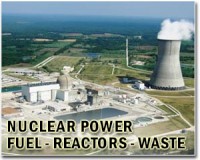 |
Tokyo (AFP) March 12, 2011 The Japanese government on Friday declared an atomic emergency and told thousands of residents living near a nuclear plant in Fukushima to evacuate, warning a small amount of radiation could be released. Trade minister Banri Kaieda said authorities were nearing a decision to release radioactive steam from a troubled nuclear reactor in a bid to ease a pressure build-up after its cooling system was damaged by a massive earthquake. "Pressure has risen in the container of the reactor and we are trying to deal with it,"a spokesman for Tokyo Electric Power, which operates the plant, told AFP. The government had earlier said no radiation leaks were detected among its reactors after the 8.9-magnitude earthquake struck Friday, Japan's biggest on record, triggering huge tsunamis. It issued an evacuation advice for as many as six thousand residents living within a three-kilometre (two-mile) radius of the Fukushima No. 1 plant, operated by Tokyo Electric Power Co. "An instruction has been issued to residents within a radius of three kilometres to evacuate and those within three to 10 kilometres to stay indoors," said Chief Cabinet Secretary Yukio Edano. "This is an evacuation instruction just for precaution, and there has been no radiation leak from the reactor." The plant had shut down after the quake, but a reactor cooling system failure had led to the evacuation instruction, a situation the government said was "under control". The US Air Force delivered coolant to a Japanese nuclear plant, US Secretary of State Hillary Clinton said Friday, without specifying which plant. Japan has dispatched around 160 military personnel, sending its chemical corps and an aircraft on a "fact finding mission" to the nuclear plant, Kyodo news reported. Prime Minister Naoto Kan had earlier said no radiation leaks had been detected from Japan's nuclear power stations after the massive quake struck the country. Japanese authorities have told the UN atomic watchdog there has been no release of radiation from a number of nuclear power plants affected by the tremor, the International Atomic Energy Agency said Friday. Earlier, the IAEA's Incident and Emergency Centre had said that the four nuclear power plants closest to the quake which occurred near the east coast of Honshu, Japan, had been "safely shut down". According to the industry ministry, a total of 11 nuclear reactors automatically shut down at the Onagawa plant, the Fukushima No. 1 and No. 2 plants and the Tokai No. 2 plant after the strongest recorded earthquake in the country's history. A fire that broke out in the turbine building of Onagawa nuclear plant in Miyagi Prefecture had been extinguished, the government said. Operator Tohoku Electric Power said there were no indications of a radioactive leak. Miyagi prefecture was one of the areas worst hit by the tsunami. Millions of households were without power in northeastern Japan, according to Tohoku Electric. Japan -- located on the "Pacific Ring of Fire," where continental plates meet and create a string of volcanoes and seismic hot spots -- records 20 percent of the world's major earthquakes. As an industrial powerhouse nation poor in energy resources, Japan also draws about 30 percent of its total power from its 53 nuclear plants.
Share This Article With Planet Earth
Related Links Nuclear Power News - Nuclear Science, Nuclear Technology Powering The World in the 21st Century at Energy-Daily.com
 Nuclear plants closest to Japan quake shut down: IAEA
Nuclear plants closest to Japan quake shut down: IAEAVienna (AFP) March 11, 2011 Four nuclear power plants closest to a massive 8.9 magnitude earthquake in Japan have been safely shut down, the UN atomic watchdog said Friday. The International Atomic Energy Agency's Incident and Emergency Centre "received information from the International Seismic Safety Centre (ISSC) at around 0815 CET (0715 GMT) this morning about the earthquake of magnitude 8.9 near the east coast of ... read more |
|
| The content herein, unless otherwise known to be public domain, are Copyright 1995-2010 - SpaceDaily. AFP and UPI Wire Stories are copyright Agence France-Presse and United Press International. ESA Portal Reports are copyright European Space Agency. All NASA sourced material is public domain. Additional copyrights may apply in whole or part to other bona fide parties. Advertising does not imply endorsement,agreement or approval of any opinions, statements or information provided by SpaceDaily on any Web page published or hosted by SpaceDaily. Privacy Statement |